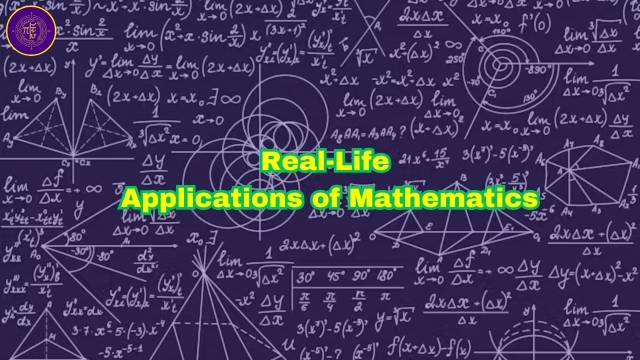
Real-Life Applications of Mathematics#
Welcome to the fascinating world of mathematics! Math isn’t just about solving equations in a classroom—it is deeply woven into the fabric of our daily lives. From predicting natural disasters to optimizing business strategies, mathematics helps us make sense of the world.
In this thread, we’ll explore 16 key areas of mathematics and their surprising real-world applications. And mind it all this tip of iceberg. This article is specially for those who who studied maths in school and college and today they are completely in the different field and they find it difficult to understand the usecases of maths except counting numbers and money calculations. :)
1. Calculus: Understanding Change and Motion#
Calculus is the backbone of engineering, physics, and medicine. It helps in:
- Medicine: Modeling blood flow, tracking disease spread, and optimizing drug dosages.
- Physics: Understanding motion, from how planets orbit to how light bends.
- Technology: Developing machine learning algorithms and neural network architectures that adjust dynamically, such as recommendation systems on Netflix and YouTube, image recognition in self-driving cars, and speech recognition in virtual assistants.
2. Statistics: Making Data-Driven Decisions#
Statistics is used in nearly every field to make sense of data and make predictions:
- Healthcare: Analyzing patient data for early disease detection.
- Economics: Predicting market trends and managing risk.
- Sports: Analyzing player performance and developing winning strategies.
3. Algebra: The Language of Problem-Solving#
Algebra helps us model real-world problems and find solutions:
- GPS & Navigation: Solving equations to determine the shortest path.
- Economics: Optimizing profit and resource allocation.
- Cryptography: Encoding and decoding messages to ensure secure communication.
4. Geometry: Designing and Constructing the World Around Us#
Geometry plays a critical role in multiple industries:
- Architecture: Designing aesthetically pleasing and structurally sound buildings.
- Medical Imaging: Enhancing techniques like CT scans and MRIs.
- Video Games: Creating realistic 3D environments.
5. Number Theory: The Foundation of Cryptography#
Number theory is crucial in cybersecurity:
- Online Transactions: Keeping bank transfers safe through encryption.
- Blockchain & Cryptocurrencies: Ensuring secure digital transactions.
- Digital Signatures: Verifying identities in a secure manner.
6. Probability: Assessing Risk and Making Predictions#
Probability helps in decision-making where uncertainty exists:
- Insurance: Calculating risks and determining fair premiums.
- Weather Forecasting: Estimating the likelihood of storms or hurricanes.
- AI & Machine Learning: Improving decision-making models for fraud detection and autonomous vehicles.
7. Topology: Understanding Shapes, Spaces, and Networks#
Topology is applied in:
- Neuroscience: Mapping brain connections to study diseases like Alzheimer’s.
- Logistics: Optimizing transportation networks and supply chains.
- Robotics: Helping robots navigate dynamic environments.
8. Combinatorics: Optimizing Schedules and Resources#
Combinatorics finds applications in:
- Airline Industry: Optimizing flight schedules to minimize delays.
- Manufacturing: Improving assembly line efficiency.
- Genetics: Understanding DNA sequencing and mutations.
9. Discrete Mathematics: The Foundation of Computer Science#
Discrete math powers modern technology:
- Software Development: Designing algorithms for apps and databases.
- Cybersecurity: Strengthening passwords and encryption.
- Artificial Intelligence: Enhancing recommendation engines and search algorithms.
10. Differential Equations: Modeling Real-World Phenomena#
Differential equations describe how things change over time:
- Climate Science: Predicting global warming patterns.
- Medicine: Modeling the spread of viruses like COVID-19.
- Engineering: Simulating fluid dynamics for aerodynamics.
11. Mathematical Physics: Bridging Math and the Universe#
Mathematical physics is vital for:
- Quantum Computing: Revolutionizing how we process information.
- Space Exploration: Calculating rocket trajectories and orbital mechanics.
- Material Science: Developing new materials for electronics and energy storage.
12. Linear Algebra: The Key to AI and Data Science#
Linear algebra is a specific area within algebra that focuses on vectors, vector spaces, matrices, and linear transformations. Linear algebra is essential in:
- Machine Learning: Powering facial recognition, fraud detection, and chatbots.
- 3D Graphics: Enhancing animation in movies and video games.
- Quantum Mechanics: Describing how particles behave at atomic levels.
13. Graph Theory: Optimizing Networks and Connections#
Graph theory plays a major role in:
- Social Media: Analyzing how people connect and influence each other.
- Traffic Flow: Reducing congestion using optimal routing.
- Epidemiology: Tracking the spread of diseases through populations.
14. Game Theory: Predicting Strategic Behavior#
Game theory helps in:
- Economics: Understanding market competition and pricing strategies.
- Politics: Analyzing voting patterns and coalition-building.
- Cybersecurity: Developing strategies to counter cyber-attacks.
15. Operations Research: Making Businesses More Efficient#
Operations research helps in:
- Supply Chain Management: Reducing costs and delivery times.
- Air Traffic Control: Managing flight schedules and airspace allocation.
- Healthcare: Optimizing hospital resource allocation.
16. Fractals: Understanding Patterns in Nature#
In math, a fractal is a never-ending pattern. Fractals are built by repeating something over and over again. Fractals may be created using numbers or with images Many fractals exist in nature, such as patterns that may be observed in ferns and broccoli. Fractals are used in:
- Medical Imaging: Enhancing MRI and CT scan analysis.
- Stock Market Analysis: Identifying trends and patterns in financial data.
- Environmental Science: Studying coastlines, mountain ranges, and natural formations.
Conclusion#
Mathematics is more than just an academic subject; it’s a universal language that shapes our daily lives. This language is more powerful than human languages like English, Chinese, or Hindi. Many of these mathematical concepts are extensively applied in Machine Learning, Data Science, and AI development, influencing everything from self-driving cars to virtual assistants.
Math is everywhere—you just need to know where to look!


Comments: